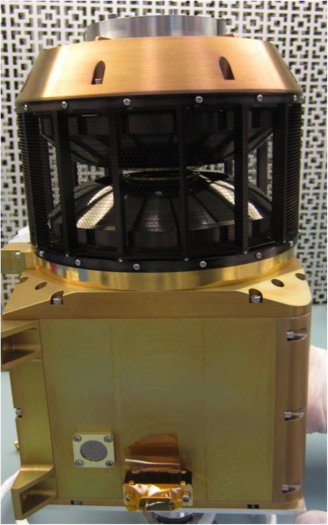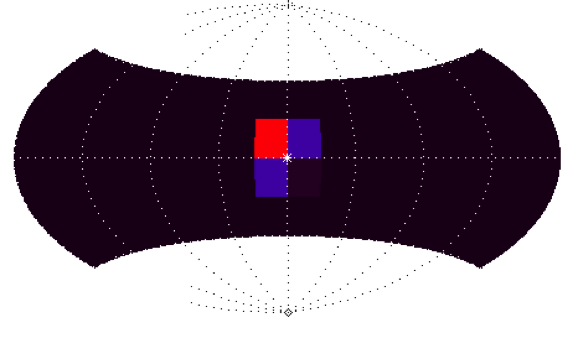- Measures the density, temperature, and velocity of solar wind ions, both in the undisturbed upstream interplanetary medium, and as they encounter the Martian atmosphere.
- Detects velocities ranging from a few tens of km/s up to 2,000 km/s.
- Allows derivation of the dynamic pressure of the solar wind, the rate at which neutral atmospheric atoms are ionized by the solar wind, and the acceleration of these newly born ions in the magnetic and electric fields around Mars. [read more]

SWIA is an electrostatic analyzer with electrostatic deflectors, measuring ions with an energy range of 5-25,000 eV/charge, with angular coverage of 360x90 degrees (minus spacecraft obstructions). SWIA is mounted on the spacecraft body and is oriented with its field of view centered on the sunward direction, ensuring good coverage of the solar wind. The instrument collects ions with a top-hat electrostatic analyzer that provides a uniform response over a 360-degree field of view. Detection anodes below a micro-channel plate detector within the instrument cover 360 degrees in a plane, with ten narrow anodes detecting ions in a 45-degree range facing the sun (to detect solar wind particles with high resolution), and fourteen wider anodes covering the other 315 degrees. The instrument utilizes electrostatic deflectors to sweep this field of view at every energy step, with a range of 90 degrees for ions up to 4.75 keV, and a reduced range at higher energies. SWIA steps the voltages on its inner hemisphere and deflectors in order to cover all energies and angles every four seconds.
Measurement Objectives
The main role of SWIA is to measure the flux of solar wind ions (primarily protons) into the Martian system. SWIA:
Useful Mission Documents
Archive Bundle Contents
Selecting and Requesting Data - The following index can be downloaded and edited to contain data that conform to your needs. This allows you to understand the scope of the data set and to tailor your request for specific products.
Citing Data Sets for Publications (to be developed)
Other Useful Products for Interpreting the Data
Measurement Objectives
The main role of SWIA is to measure the flux of solar wind ions (primarily protons) into the Martian system. SWIA:
Useful Mission Documents
Mission Description
Spacecraft Description
Software Interface Specification (SIS) - Description of the instrument and data structures
Calibration Document - Description of calibration methods
Spacecraft Description
Software Interface Specification (SIS) - Description of the instrument and data structures
Calibration Document - Description of calibration methods
Archive Bundle Contents
Documentation - Directory containing the document collection, which includes references to refereed journals using this instrument, and information about calibration and explanation of data structures.
Raw Data - Directory containing the raw data files
Calibrated Data - Directory containing the calibrated data files
Derived Data - Directory containing advanced products
Raw Data - Directory containing the raw data files
Calibrated Data - Directory containing the calibrated data files
Derived Data - Directory containing advanced products
Selecting and Requesting Data - The following index can be downloaded and edited to contain data that conform to your needs. This allows you to understand the scope of the data set and to tailor your request for specific products.
As-flown Index - List of actual observations in order of acquisition
Requesting Data You will need to upload your edited file
Requesting Data You will need to upload your edited file
Citing Data Sets for Publications (to be developed)
Other Useful Products for Interpreting the Data
References - Publications by team members
Other Potential Relevant Data - Data that may be relevant from missions other than MAVEN
SPICE - Archived MAVEN SPICE ancillary data providing observational geometry (positions, orientations, instrument pointing, time conversions, etc.) are available from the PDS NAIF Node.
Other Potential Relevant Data - Data that may be relevant from missions other than MAVEN
SPICE - Archived MAVEN SPICE ancillary data providing observational geometry (positions, orientations, instrument pointing, time conversions, etc.) are available from the PDS NAIF Node.
 PDS: The Planetary Atmospheres Node
PDS: The Planetary Atmospheres Node





